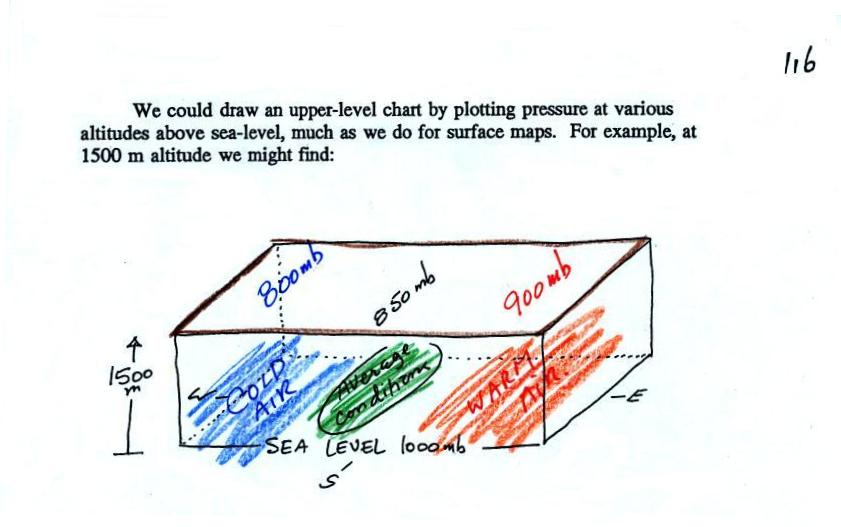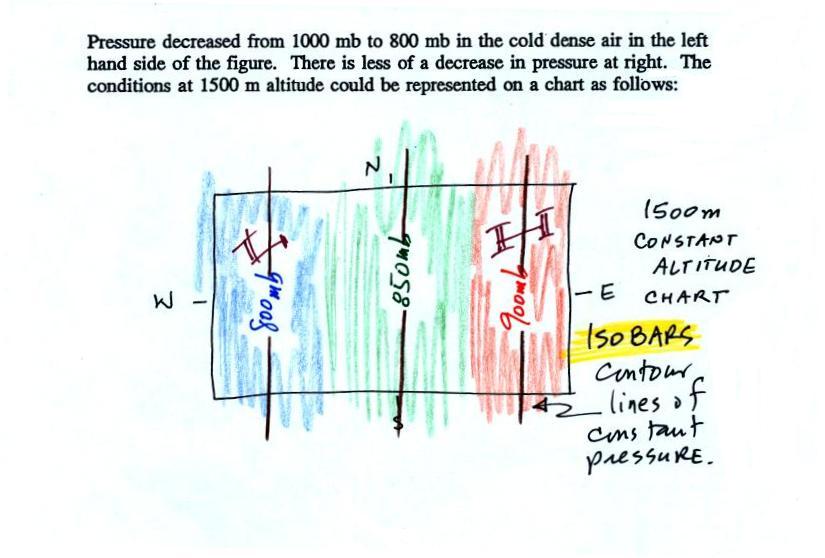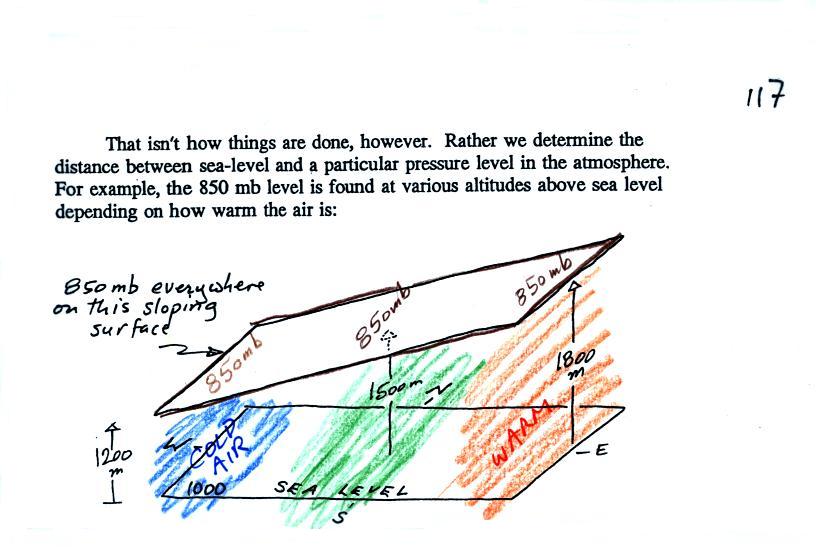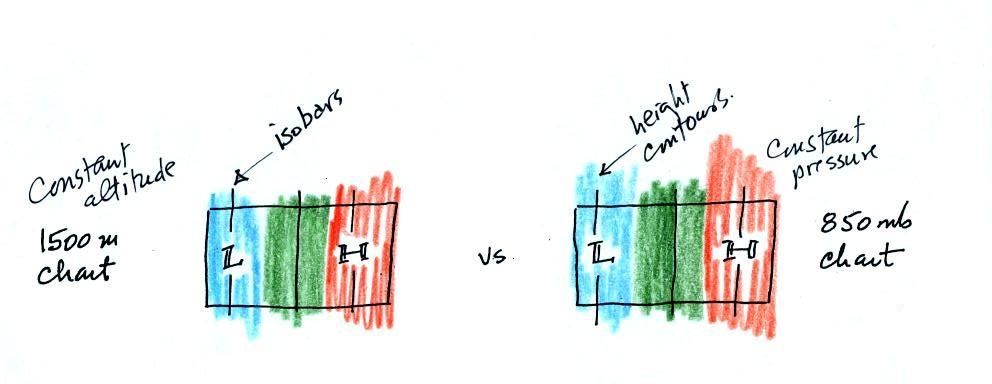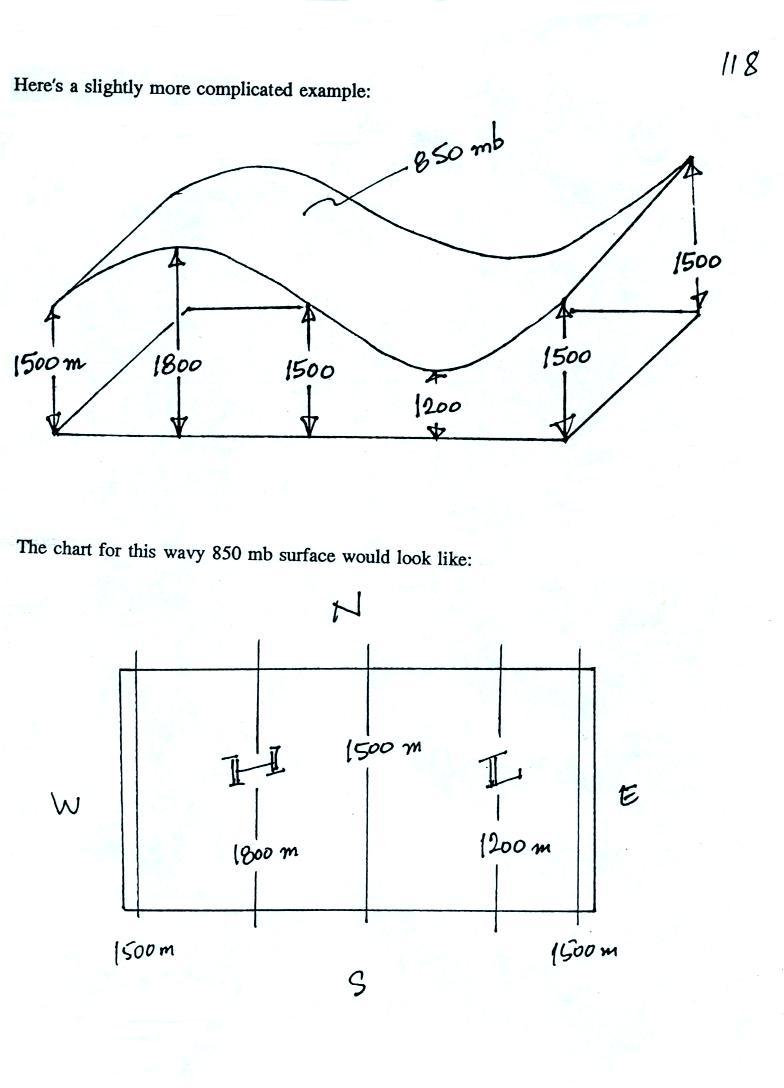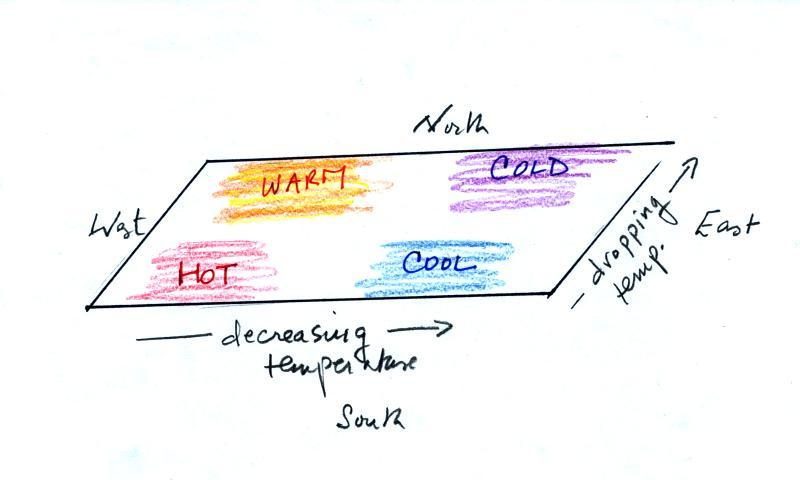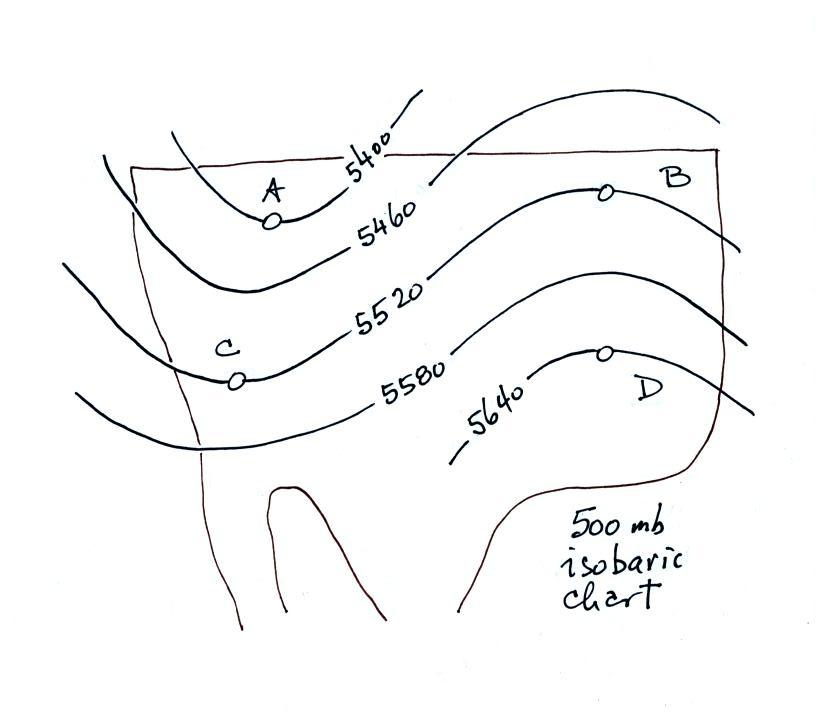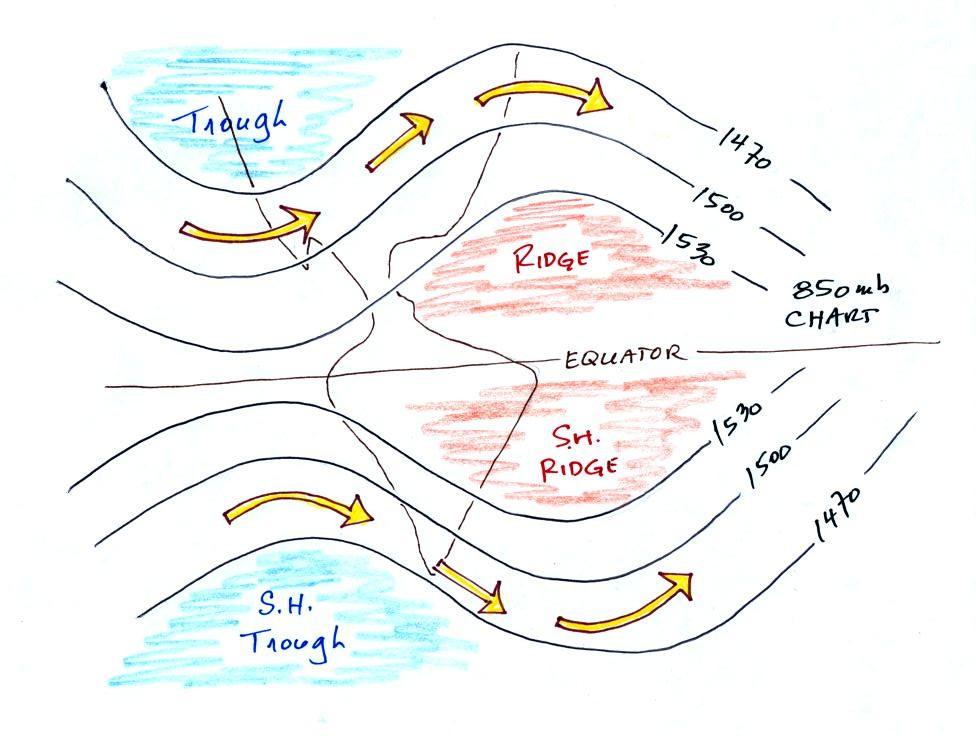Upper Level Charts Pt. 2
There is an Optional
Assignment that accompanies the upper level charts reading
material.
Here's a little more in depth look at upper-level charts.
You'll find most of the figures below on pps. 115-119 in the
photocopied ClassNotes.
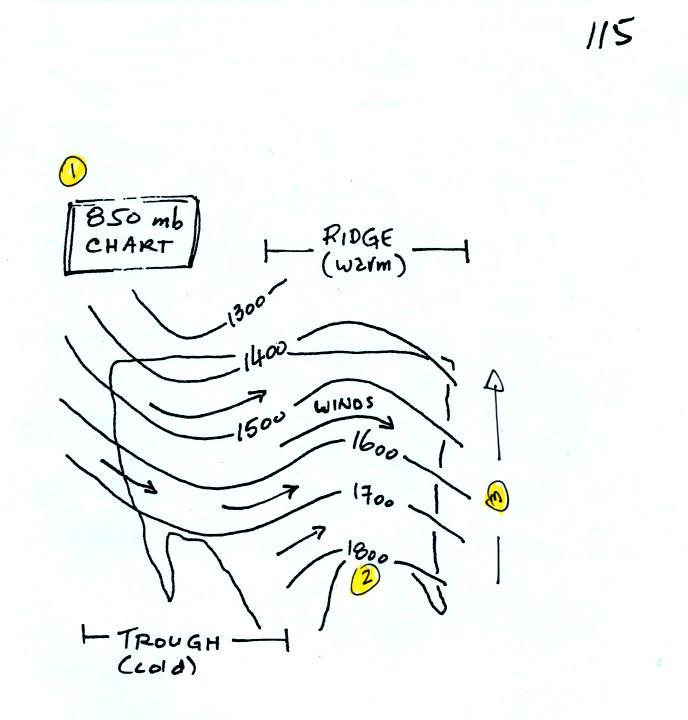
Hopefully you still remember the trought (u-shape)
and ridge (n-shape) features introduced in
Pt. 1, the fact that cold air is found under an upper level trough
and warm air below a ridge, and that the upper level winds blow
parallel to the contour lines and from west to east.
1. After you've finished reading this
section you should better understand what the title "850 mb Chart"
on the upper level map above refers to.
2. You should also understand what the
numbers on the contour lines represent and what their units
are. On a surface map contours of pressure, isobars, are
normally drawn. That is usually not the case on upper level
charts. You'll have a better idea of where the names trough
and ridge come from.
3. Note that the values on the contours
decrease as you move from the equator toward higher
latitude. You should understand why that happens
(temperature also decreases as you move toward higher latitude,
maybe that is the explanation). You should understand why
troughs and ridges are associated with cold and warm air,
respectively.
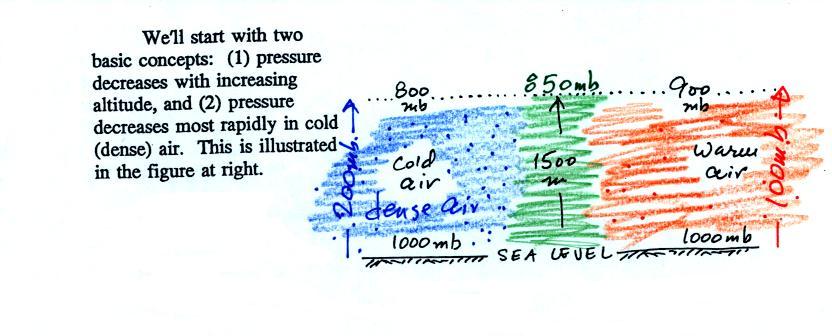
You really only need to remember two things from earlier in the
semester (you'll find the figure above at the bottom of p. 115 in
the photocopied Classnotes): (1) pressure decreases with
increasing altitude, and (2) pressure decreases more rapidly
in cold high-density air than it does in warm low density
air.
Pressure drops from 1000 mb to 800 mb, a 200 mb change, when
moving upward 1500 meters in the cold air. It decreases from
1000 mb to 900 mb, only 100 mb, in the same distance in the
warm low density air.
Isobars on constant altitude upper level charts
One way of depicting upper level conditions would be to
measure pressure values at some fixed altitude above the
ground. This approach is shown above. Pressures range
from 800 mb to 900 mb at 1500 meters altitude. The pressure
pattern could then be plotted on a constant altitude chart using
isobars (figure below). Note the lowest pressures are found
in the cold air, higher pressures would be found in the warm air.
That would seem to be a logical way of mapping upper level
atmospheric conditions. Unfortunately that isn't how things
are done.
Height contours on constant pressure (isobaric) upper
level charts
Just to make life difficult for NATS 101 students,
meterologists do things differently. Rather than
plotting conditions at a constant altitude above the ground,
meterologists measure and plot conditions at a particular
reference pressure level above the ground.
In the picture above you start at the ground (where the pressure
is 1000 mb) and travel upward until you reach 850 mb
pressure. You make a note of the altitude at which that
occurs. In the cold dense air at the left pressure decreases
rapidly so you wouldn't need to go very high, only 1200
meters. In the warm air at right pressure decreases more
slowly, you would have to going higher, to 1800 m.
Every point on the sloping surface above has the same pressure,
850 mb. The altitude above the ground is what is
changing. You could draw a topographic map of the sloping
constant pressure surface by drawing contour lines of altitude or
height.
The two kinds of charts (constant altitude or constant pressure)
are redrawn below.
The numbers on the contour lines have been left off in order to
clearly see that both types of maps have the same overall pattern
(they should because they're both depicting the same upper level
atmospheric conditions).
In the example above temperature changed smoothly from cold to
warm as you move from left to right (west to east).
See if you can figure out what temperature pattern is producing
the wavy 850 mb constant pressure surface below.
It shouldn't be too hard if you remember that the 850 mb level
will be found at relatively high altitude in the warm air where
pressure decreases slowly with increasing altitude. The 850
mb level will be found closer to the ground in cold air where
pressure decreases rapidly with increasing altitude. Click here when you think you have it
figured out.
In the next figure we are going to add south to north temperature
changes in addition to the west to east temperature gradient.
Here's what the temperature pattern will look like.
Temperature drops as you move from west to east (as it did in the
previous pictures) and now it drops as you move from south to
north. What will the wavy 850 mb constant pressure surface
look like now? Click here
when you think you know (or if you just want to see the answer and
would rather not think about it).
Now let's go back to the figure at the top of p. 115 in the
photocopied Classnotes.
1. The title tells you this is a map depicting the 850 mb
constant pressure level in the atmosphere.
2. Height contours are drawn on the chart. They show
the altitude, in meters, of the 850 mb pressure level at different
points on the map.
3. The numbers get smaller as you head north because the air
up north is colder. The 850 mb level is closer to the
ground.
Here's
a figure with some questions to test your understanding of this
material.
This is a 500 mb constant pressure chart
not an 850 mb chart like in the previous examples.
Is the pressure at Point C greater
than, less than, or equal to the pressure at Point D (you can
assume that Points C and D are at the same latitude)? How do
the pressures at Points A and C compare?
Which of the four points (A, B, C, or D) is found at the lowest
altitude above the ground, or are all four points found at the
same altitude?
The coldest air would probably be found below which of the four
points? Where would the warmest air be found?
What direction would the winds be blowing at Point C?
Click here for all the answers.
Finally
we will compare upper level charts in the northern and southern
hemisphere
The contour values get smaller as you move toward colder
air. The cold air is in the north in the northern hemisphere
and in the south in the southern hemisphere. The winds blow
parallel to the contour lines and from west to east in both
hemispheres.



